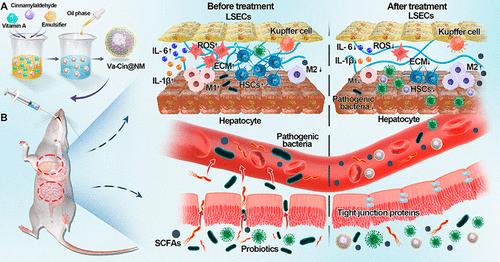维生素A集成肉桂醛纳米乳:通过肠-肝轴调节对抗肝纤维化的纳米治疗方法
IF 16
1区 材料科学
Q1 CHEMISTRY, MULTIDISCIPLINARY
引用次数: 0
摘要
肝纤维化是由大多数慢性肝病引起的复杂过程,目前仍缺乏有效的治疗方法。越来越多的证据表明肝纤维化与“肠-肝轴”有关,肠道微生物群-宿主平衡的破坏是其进展的关键因素。肉桂醛(Cin)是一种具有抗氧化、抗炎和抗细胞毒性的天然化合物,已显示出对抗肝星状细胞(HSC)活化的潜力。此外,研究显示,Cin可促进肠道内的益生菌,从而恢复健康的微生物群落。这些特点使其成为通过调节肝肠轴治疗肝纤维化的有希望的候选药物。在本研究中,开发了一种维生素a (Va)配制的Cin纳米乳(Va-Cin@NM),以增强Cin的物理化学稳定性,同时保持肠道内稳态并促进靶向肝脏沉积。在胆管结扎(BDL)诱导的大鼠肝纤维化中,Va-Cin@NM干预可显著减少肝内胆管样结构增生和胶原沉积。这些影响可能归因于肠道微生物群的恢复,短链脂肪酸(SCFA)浓度的增加和肠道完整性的改善。此外,Va-Cin@NM治疗抑制了肝脏中的有害细菌种群,从而减轻了免疫损伤和炎症细胞募集。因此,氧化应激和HSC活化被减弱。总体而言,Va-Cin@NM通过调节肠-肝轴显示了作为肝纤维化纳米治疗方法的巨大潜力。本文章由计算机程序翻译,如有差异,请以英文原文为准。

Vitamin A-Integrated Cinnamaldehyde Nanoemulsion: A Nanotherapeutic Approach To Counteract Liver Fibrosis via Gut–Liver Axis Modulation
Liver fibrosis, a complex process resulting from most chronic liver diseases, remains devoid of effective treatments. An increasing body of evidence links liver fibrosis to the “gut–liver axis”, with disruptions in the gut microbiota–host balance emerging as a critical contributor to its progression. Cinnamaldehyde (Cin), a natural compound with antioxidant, anti-inflammatory, and anticytotoxic properties, has shown potential in counteracting hepatic stellate cell (HSC) activation. Additionally, Cin has been shown to promote probiotics in the intestine, thereby restoring a healthy microbial community. These characteristics position Cin as a promising candidate for liver fibrosis treatment through modulation of the gut–liver axis. In this study, a Vitamin A (Va)-formulated Cin Nanoemulsion (Va-Cin@NM) was developed to enhance the physicochemical stability of Cin while preserving intestinal homeostasis and facilitating targeted liver deposition. In bile duct ligation (BDL)-induced liver fibrosis in rats, Va-Cin@NM intervention significantly reduced bile duct-like structure proliferation and collagen deposition in the liver. These effects are likely attributed to the restoration of gut microbiota, increased short-chain fatty acid (SCFA) concentrations, and improved intestinal integrity. Moreover, Va-Cin@NM treatment suppressed harmful bacterial populations in the liver, thus mitigating immune injury and inflammatory cell recruitment. Consequently, oxidative stress and HSC activation were attenuated. Overall, Va-Cin@NM demonstrates significant potential as a nanotherapeutic approach for liver fibrosis by modulating the gut–liver axis.
求助全文
通过发布文献求助,成功后即可免费获取论文全文。
去求助
来源期刊

ACS Nano
工程技术-材料科学:综合
CiteScore
26.00
自引率
4.10%
发文量
1627
审稿时长
1.7 months
期刊介绍:
ACS Nano, published monthly, serves as an international forum for comprehensive articles on nanoscience and nanotechnology research at the intersections of chemistry, biology, materials science, physics, and engineering. The journal fosters communication among scientists in these communities, facilitating collaboration, new research opportunities, and advancements through discoveries. ACS Nano covers synthesis, assembly, characterization, theory, and simulation of nanostructures, nanobiotechnology, nanofabrication, methods and tools for nanoscience and nanotechnology, and self- and directed-assembly. Alongside original research articles, it offers thorough reviews, perspectives on cutting-edge research, and discussions envisioning the future of nanoscience and nanotechnology.
 求助内容:
求助内容: 应助结果提醒方式:
应助结果提醒方式:


